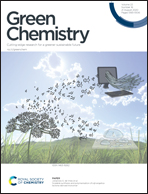Hydrosilylation and hydroboration in a sustainable manner: from Earth-abundant catalysts to catalyst-free solutions
Abstract
Hydroelementation enables a facile reduction or functionalization of several unsaturated systems, and thus activation of such bonds like B–H and Si–H is a powerful synthetic tool. Furthermore, the addition of these moieties is in line with the main aspects of green chemistry, in particular with regard to atom economy. In view of the above, several effective methods have been developed in recent years. This critical review will mainly detail solutions utilizing Earth-abundant catalysts (based on s-block elements), although their potential will be particularly discussed in relation to sustainability problems. Besides, there is increasing interest in catalyst-free and solvent-free approaches, which will also be included. This review highlights recent developments in hydroboration and hydrosilylation of unsaturated carbon–heteroatom (O, N) moieties and covers the literature from the last ten years.



 Please wait while we load your content...
Please wait while we load your content...